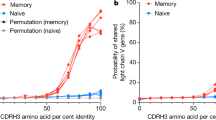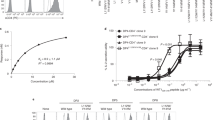Abstract
The major histocompatibility complex (MHC) is a cluster of tightly linked genes whose products are of central importance in the functioning of the immune system. Class I and II MHC antigens are integral membrane proteins which regulate cell-surface interactions between T cells and their targets1–3, while class III antigens are components of the complement system of serum proteins4. All available evidence indicates that the structure and function of the MHC and its gene products are highly conserved among species (for review, see ref. 5). We recently reported6 the existence in murine cells of a fourth class of MHC-linked polypeptides which are biochemically and genetically distinct from previously identified MHC gene products: BALB.B anti-BALB/c (anti-H–2d) antiserum immunoprecipitates a set of 16 cytoplasmic low-molecular weight polypeptides (LMP) from BALB/c spleen cells and from the WEHI-3 cell line. The production of these peptides is coordinately regulated (by immune interferon) with the production of the class I and II MHC antigens7,8, suggesting that they too are functionally relevant to the immune system. We demonstrate here that these 16 polypeptides are associated with one another in vivo as a very large (580,000-molecular weight, Mr) noncovalent complex. The unusual nature of this complex has allowed the non-immunochemical identification of similar complexes from (serologically negative) H–2b murine cells and from a human cell line. Thus, LMP antigens display two properties in common with other MHC antigens: they are both polymorphic and genetically conserved across species.
This is a preview of subscription content, access via your institution
Access options
Subscribe to this journal
Receive 51 print issues and online access
$199.00 per year
only $3.90 per issue
Buy this article
- Purchase on Springer Link
- Instant access to full article PDF
Prices may be subject to local taxes which are calculated during checkout
Similar content being viewed by others
References
Zinkernagel, R. M. & Doherty, P. C. Adv. Immun. 27, 51–177 (1980).
Rosenthal, A. S. Immun. Rev. 40, 136–152 (1978).
Klein, J., Juretic, A., Baxevanis, C. N. & Nagy, Z. A. Nature 291, 455–460 (1981).
Shreffler, D. C. Transplantn Rev. 32, 140–167 (1976).
Goetze, D. (ed.) The Major Histocompatibility System in Man and Animals (Springer, Berlin, 1977).
Monaco, J. J. & McDevitt, H. O. Proc. natn. Acad. Sci. U.S.A. 79, 3001–3005 (1982).
Monaco, J. J., Ku, G. & McDevitt, H. O. in Ir Genes: Past, Present and Future (eds Pierce, C. W., Cullen, S. E., Kapp, J. A., Schwarte, B. D. & Shreffler, D. C.) 69–73 (Humana, Clifton, New Jersey, 1983).
Monaco, J. J. & McDevitt, H. O. J. Immun. (submitted).
Mauel, J. & Defendi, V. J. exp. Med. 134, 335–350 (1971).
Lanier, L. L. et al. Immunogenetics 16, 367–371 (1982).
Ralph, P., Moore, M. A. S. & Nilsson, K. J. exp. Med. 143, 1528–1533 (1976).
Wool, I. G. A. Rev. Biochem. 48, 719–754 (1979).
Author information
Authors and Affiliations
Rights and permissions
About this article
Cite this article
Monaco, J., McDevitt, H. H–2-linked low-molecular weight polypeptide antigens assemble into an unusual macromolecular complex. Nature 309, 797–799 (1984). https://doi.org/10.1038/309797a0
Received:
Accepted:
Issue Date:
DOI: https://doi.org/10.1038/309797a0
This article is cited by
-
Genetics of antigen processing and presentation
Immunogenetics (2019)
-
Immuno-waste exposure and further management
Nature Immunology (2012)
-
Emerging roles of immunoproteasomes beyond MHC class I antigen processing
Cellular and Molecular Life Sciences (2012)
-
The ubiquitin-proteasome system
Journal of Biosciences (2006)
-
Structural features of archaebacterial and eukaryotic proteasomes
Molecular Biology Reports (1995)
Comments
By submitting a comment you agree to abide by our Terms and Community Guidelines. If you find something abusive or that does not comply with our terms or guidelines please flag it as inappropriate.



